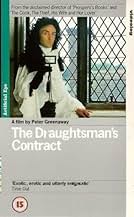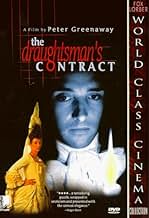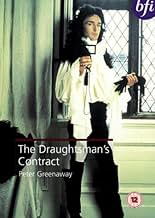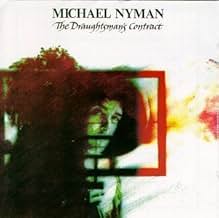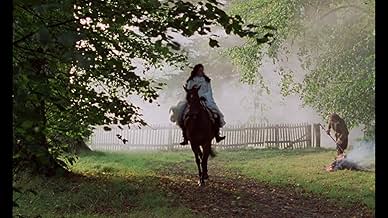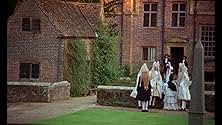VALUTAZIONE IMDb
7,2/10
11.662
LA TUA VALUTAZIONE
In una villa della campagna inglese, alla metà del Seicento, un pittore è incaricato di realizzare dodici disegni della dimora in cambio dei favori della proprietaria. Osservando il paesaggi... Leggi tuttoIn una villa della campagna inglese, alla metà del Seicento, un pittore è incaricato di realizzare dodici disegni della dimora in cambio dei favori della proprietaria. Osservando il paesaggio, scopre che è stato commesso un omicidio.In una villa della campagna inglese, alla metà del Seicento, un pittore è incaricato di realizzare dodici disegni della dimora in cambio dei favori della proprietaria. Osservando il paesaggio, scopre che è stato commesso un omicidio.
- Premi
- 1 vittoria e 4 candidature totali
Anne-Louise Lambert
- Mrs. Talmann
- (as Anne Louise Lambert)
Nicholas Amer
- Mr. Parkes
- (as Nicolas Amer)
Lynda La Plante
- Mrs. Clement
- (as Lynda Marchal)
Alastair G. Cumming
- Philip - Mr. Neville's assistant
- (as Alastair Cummings)
Recensioni in evidenza
Peter Greenaway's first commercially released feature film is a calling card of dazzling virtuosity.
Peter Greenaway's smart, outrageous, and utterly original historic movie is part comedy of manners and part murder mystery, as a late 17th century draughtsman (Anthony Higgins) is tasked with producing a series of drawings for the Herbert family estate by the lady of the manor (Janet Suzan) in order to please her husband, but he ends up pleasing himself with both Mrs Herbert and her daughter (Anne-Louise Herbert), before the husband is found dead in the moat and he becomes prime suspect in his murder. This was Greenaway's first conventional feature film, it shows him at his best and most playful, and is a calling card of dazzling virtuosity. The original cut ran in excess of three hours but was edited down to 103 minutes for release to make it easier to watch. It is still a puzzle box of a movie and a real strange delight though, featuring elaborate and slightly exaggerated (for eye catching effect) period costumes, a wonderful score by Michael Nyman which borrows widely from Henry Purcell, that reflects the period setting whilst managing to rock with a vengeance, and a 'living statue' that roams the garden unseen to all but children, it is a movie that you won't forget in a hurry. Incidentally, Greenaway trained as an artist before he became a filmmaker, and the hands seen drawing in the film are his own, as are the completed drawings.
A most extraordinary film. A fascinating study of manipulation and murder, of sex, power and the abuse of sex and power. This is not always an easy film to like, it has a coldly clinical approach to its subject and protagonists which produces an intentionally distancing effect.
In one scene, the Draughtsman invites the Lady of the House to examine a painting, owned by her husband, in which a complex allegory appears to be being acted out. I see this as an analogy for the film as a whole - it is an arch, stylised, intelligent and beautiful puzzle (a murder-mystery) in which the audience is encouraged to consider the motives and objectives of the characters, but from which many important clues appear to have been deliberately removed.
This might all sound frustrating, but I find the film endlessly intriguing and entertaining. It's like a very clever and stunningly photographed Agatha Christie mystery, but without an annoying sleuth who comes along at the end and solves everything "oh-so-neatly".
The photography is exemplary (the cinematographer, Curtis Clark, seems to have done little else of note), with the camera hardly moving at all, except for an occasional tracking shot. The Kent countryside used to maximum effect, and the costumes are sumptuous (especially the wigs!). The music is also superb, with Michael Nyman producing probably his finest score.
An engaging, puzzling, visually stunning and, ultimately, rather disturbing film.
In one scene, the Draughtsman invites the Lady of the House to examine a painting, owned by her husband, in which a complex allegory appears to be being acted out. I see this as an analogy for the film as a whole - it is an arch, stylised, intelligent and beautiful puzzle (a murder-mystery) in which the audience is encouraged to consider the motives and objectives of the characters, but from which many important clues appear to have been deliberately removed.
This might all sound frustrating, but I find the film endlessly intriguing and entertaining. It's like a very clever and stunningly photographed Agatha Christie mystery, but without an annoying sleuth who comes along at the end and solves everything "oh-so-neatly".
The photography is exemplary (the cinematographer, Curtis Clark, seems to have done little else of note), with the camera hardly moving at all, except for an occasional tracking shot. The Kent countryside used to maximum effect, and the costumes are sumptuous (especially the wigs!). The music is also superb, with Michael Nyman producing probably his finest score.
An engaging, puzzling, visually stunning and, ultimately, rather disturbing film.
Guess I really like this sort of period movies, about the British upper-class in the 17th century. The movies have an own unique kind of style and atmosphere over them. This especially really goes for this unique little film.
it's a very witty movie and halve way through it also becomes obvious exactly how intelligently the movie is written and constructed. At first it doesn't look like the movie is heading anywhere and it's merely a good and enjoyable movie filled with some slightly subtle eccentric and quirky characters. But about halve way through it becomes clear that the intentions within the story and the intentions of the characters have way more in to them, when the movie becomes more of a murder-mystery and layered and the character's motivations all start to take form and become clear. It makes the movie surprisingly and delightful. It's a really well constructed and visually crafted movie from Peter Greenaway.
The movie doesn't have the Jane Austen kind of story and approach but more like "Barry Lyndon" with the same certain quirkiness in it, if I need to compare it to anything else. The movie has a sort of a surreal kind of atmosphere over it, which gets strengthened all the more by the outrageous costumes and wigs, thick accents and extremely difficult but beautiful to listen to- dialog and of course the special kind of characters that are in the movie. It's also a very sexy and sort of erotic movie to watch at, with almost always a sort of sexual tension in the atmosphere during the entire movie, despite not having any real nudity or explicit nude scene's in it.
The whole movie is almost entire filmed in a stage-play kind of approach, with no moving camera's and long sequences filled with dialog. Really the sort of stuff you normally experience during a stage-play. It all adds up to the reasons why this movie is a quite unique and delightful little movie to watch.
This movie is a great watch, as long as you're capable of handling the long and difficult dialog and the more stage-play kind of storytelling.
9/10
http://bobafett1138.blogspot.com/
it's a very witty movie and halve way through it also becomes obvious exactly how intelligently the movie is written and constructed. At first it doesn't look like the movie is heading anywhere and it's merely a good and enjoyable movie filled with some slightly subtle eccentric and quirky characters. But about halve way through it becomes clear that the intentions within the story and the intentions of the characters have way more in to them, when the movie becomes more of a murder-mystery and layered and the character's motivations all start to take form and become clear. It makes the movie surprisingly and delightful. It's a really well constructed and visually crafted movie from Peter Greenaway.
The movie doesn't have the Jane Austen kind of story and approach but more like "Barry Lyndon" with the same certain quirkiness in it, if I need to compare it to anything else. The movie has a sort of a surreal kind of atmosphere over it, which gets strengthened all the more by the outrageous costumes and wigs, thick accents and extremely difficult but beautiful to listen to- dialog and of course the special kind of characters that are in the movie. It's also a very sexy and sort of erotic movie to watch at, with almost always a sort of sexual tension in the atmosphere during the entire movie, despite not having any real nudity or explicit nude scene's in it.
The whole movie is almost entire filmed in a stage-play kind of approach, with no moving camera's and long sequences filled with dialog. Really the sort of stuff you normally experience during a stage-play. It all adds up to the reasons why this movie is a quite unique and delightful little movie to watch.
This movie is a great watch, as long as you're capable of handling the long and difficult dialog and the more stage-play kind of storytelling.
9/10
http://bobafett1138.blogspot.com/
Hugely enjoyable, if somewhat a tad too clever for its own good. A very good English director's attempt to be more continental, by being deliberately obscure, and throwing in large dollops of raunchy eroticism. Imagine if you will an episode of PBS's Mystery set during the Restoration, with a script by Einstein, and direction by Frederico Fellini.
Two excellent stage actors - Anthony Higgins and Janet Suzman - in combination with the very sultry and seldom seen Australian actress Anne Louise Lambert, act their sexy sox off in this delightful delicate pastry of a movie. In the year 1694 an artist is commissioned to create a series of precise drawings of an enormous country house. The twist is that his agreed form of payment is most unusual.
Michael Nyman's score is a careful, yet loud, modern arrangement with contemporary wind and string instruments. The photography by Curtis Clark is incredible, and these two creative artists convince you, you are in the 17th Century. The interior scenes are lit only by candlelight - as was also the case in Kubrick's superb historical masterpiece Barry Lyndon. This movie somehow combines elements of sophisticated themes of woman's self-empowerment, the inhumanity of the aristocracy, mathematics, and Benny Hill eroticism. Really rather wonderful and unique, but also in-retrospect, less than the sum of its parts. For a superior Peter Greenaway picture, try Drowning By Numbers, A Zed and Two Naughts, and The Cook, the Wife, etc..
Two excellent stage actors - Anthony Higgins and Janet Suzman - in combination with the very sultry and seldom seen Australian actress Anne Louise Lambert, act their sexy sox off in this delightful delicate pastry of a movie. In the year 1694 an artist is commissioned to create a series of precise drawings of an enormous country house. The twist is that his agreed form of payment is most unusual.
Michael Nyman's score is a careful, yet loud, modern arrangement with contemporary wind and string instruments. The photography by Curtis Clark is incredible, and these two creative artists convince you, you are in the 17th Century. The interior scenes are lit only by candlelight - as was also the case in Kubrick's superb historical masterpiece Barry Lyndon. This movie somehow combines elements of sophisticated themes of woman's self-empowerment, the inhumanity of the aristocracy, mathematics, and Benny Hill eroticism. Really rather wonderful and unique, but also in-retrospect, less than the sum of its parts. For a superior Peter Greenaway picture, try Drowning By Numbers, A Zed and Two Naughts, and The Cook, the Wife, etc..
Being of English origin the film has a particular fascination. Certain things become apparent if you know England well, but also I suspect on repeated viewing.
A tale of conceit, deception and power. The conceit of the Draughtsman, all too apparent, is matched by the conceit of the upper classes as the film unfolds. The pictoral conceit referred to in the film repeatedly is matched by a pictoral conceit played on the viewer: the wigs were never that big, the house, garden and grounds stunning and the weather too perfect.
Deception exists at many levels. The viewer is deceived as to where the houses and events take place. The allusions are to Southampton and surrounding areas. Being from the Southampton area I realized this wasn't Southampton. Though it could possibly have been. The deception was convincing. The location is Kent. I believe this deception, which fits so nicely in the film anyway, was pulled so that the owner of the house where the film is centred around would not be invaded by tourists. A nice touch which I suspect follows the line in the film, something like this), "Do you think Mrs Talbot is a lady who likes her gravel being kicked around by a pack of dogs."
The arrogance and exploitation of the ladies of the house by the Draughtsman, readily apparent, is more sinisterly exceeded by the arrogance and exploitation of the Draughtsman by the ladies. The Draughtsman provides a cover for murder, solves the problem of transfer of the property by siring a child and finally ends up as the scapegoat for murder. While the Draughtsman may appear to be playing with the household for his own amusement, the Draughtsman himself is the focus of a much more brutal and more deadly game.
Like all the best films there is much going on in the film. The lines and language are wonderfully rich. The camera merely shows you the events. And it is not above deceiving you as a viewer. Trying to make sense of it all is great fun. Many things I didn't even see until the second or third viewing, let alone make sense of them!
A beautiful allegory which slowly unfolds and challenges the senses. Much like The Prisoner (1967) tv series, and hopefully The Prisoner (2000) movie.
A tale of conceit, deception and power. The conceit of the Draughtsman, all too apparent, is matched by the conceit of the upper classes as the film unfolds. The pictoral conceit referred to in the film repeatedly is matched by a pictoral conceit played on the viewer: the wigs were never that big, the house, garden and grounds stunning and the weather too perfect.
Deception exists at many levels. The viewer is deceived as to where the houses and events take place. The allusions are to Southampton and surrounding areas. Being from the Southampton area I realized this wasn't Southampton. Though it could possibly have been. The deception was convincing. The location is Kent. I believe this deception, which fits so nicely in the film anyway, was pulled so that the owner of the house where the film is centred around would not be invaded by tourists. A nice touch which I suspect follows the line in the film, something like this), "Do you think Mrs Talbot is a lady who likes her gravel being kicked around by a pack of dogs."
The arrogance and exploitation of the ladies of the house by the Draughtsman, readily apparent, is more sinisterly exceeded by the arrogance and exploitation of the Draughtsman by the ladies. The Draughtsman provides a cover for murder, solves the problem of transfer of the property by siring a child and finally ends up as the scapegoat for murder. While the Draughtsman may appear to be playing with the household for his own amusement, the Draughtsman himself is the focus of a much more brutal and more deadly game.
Like all the best films there is much going on in the film. The lines and language are wonderfully rich. The camera merely shows you the events. And it is not above deceiving you as a viewer. Trying to make sense of it all is great fun. Many things I didn't even see until the second or third viewing, let alone make sense of them!
A beautiful allegory which slowly unfolds and challenges the senses. Much like The Prisoner (1967) tv series, and hopefully The Prisoner (2000) movie.
Lo sapevi?
- QuizDirector Peter Greenaway, a former art student, created the sketches that feature in the film. In fact the close-up shots of the draughtsman drawing are of his hands.
- BlooperThe cooing of a collared dove is not a sound that would have fallen on Jacobean ears, as the species was unknown in Britain until 1955.
- Citazioni
Mr. Neville: You must forgive my curiosity, madam, and open your knees.
- Versioni alternativeWhen Peter Greenaway screened the movie at festivals in 1982, it ran a full three hours. Included in this footage is a full and further explained rationale for the moving statue.
I più visti
Accedi per valutare e creare un elenco di titoli salvati per ottenere consigli personalizzati
- How long is The Draughtsman's Contract?Powered by Alexa
Dettagli
- Data di uscita
- Paese di origine
- Lingue
- Celebre anche come
- The Draughtsman's Contract
- Luoghi delle riprese
- Aziende produttrici
- Vedi altri crediti dell’azienda su IMDbPro
Botteghino
- Budget
- 320.000 £ (previsto)
- Lordo Stati Uniti e Canada
- 2.256.246 USD
- Lordo in tutto il mondo
- 2.283.233 USD
Contribuisci a questa pagina
Suggerisci una modifica o aggiungi i contenuti mancanti

Divario superiore
By what name was I misteri del giardino di Compton House (1982) officially released in Canada in French?
Rispondi




